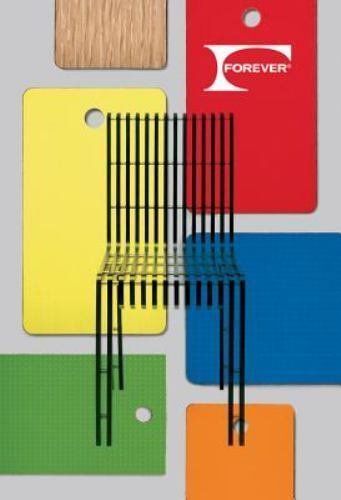Glamour! Durability! Beauty! Sequins! Submarines! The rich and varied history of, yes, Formica, is explored in this perky paperback. Essays by design critics Phil Patton and Alexandra Lange and Peter York, a management consultant and author, bring depth, getting beneath the surface, if you will, of the lowly (or luxurious, depending on your perspective) laminate., Suddenly out of left field comes Formica Forever, possibly the most delightful and instructive book evver written on the topic of building a brand.Formica Forever is corporate self-promotion, but understated self-promotion of rare quality and even rarer modesty. Editorial design is by Pentagram, which will alert the design-savvy to a serious intention to get this book exactly right., “A portable exhibition” is how Pentagram’s Abbott Miller describes the book he designed that commemorates the 100th anniversary of Formica. With more than 400 archival images, Formica Forever tells the story of the now-ubiquitous laminate. Developed in 1913 as a substitute “for mica,” it was first employed in the manufacture of electrical insulation. As the understanding of Formica’s capabilities expanded beyond utility and new applications brought pattern, texture, and color “to the table,” as Miller puts it, the material began to be used for interiors and consumers products. Essays by Phil Patton, Alexandra Lange, and Peter York address, respectively, the history of the company, the adoption of the laminate by modern architects and designers, and how Formica encouraged the postwar ideal of an easy-upkeep world., Ah, the sweet smell of a retro material getting its own celebratory monograph. Formica was born out of the early twentieth century boom in artificial materials, but found its place in popular culture in the boom years following World War 2. Formica became a key component of America’s populist modernism, bright, no-fuss, wipe clean and futuristic. The company went worldwide, becoming the power behind pop and a driving force in the DIY drive to reinvent the modern home. Published to celebrate the company’s centenary, Formica Forever is a fascinating corporate history allied to an enviable image bank., Durable, colorful, and easy to clean, Formica laminate – kraft paper that has been dipped in resin, coated with melamine, compressed, and heated – is all around us, as illustrated Formica Forever (Metropolis), a celebration of the company’s centennial. Packed with irresistibly kitschy vintage ads, the book details the material’s many uses, including in the interior of the QE2, in kitchens and bathrooms across America (remember the ubiquitous boomerang pattern?), and in artwork by contemporary architects Zaha Hadid and Frank Gehry., When one imagines a mid-century kitchen, it’s difficult not to picture a brightly coloured laminate table with matching chairs at its centre. To fete its 100th anniversary, Formica, the company that pioneered the material, has released a 408-page commemorative picture book chronicling its history. Designed by New York’s Pentagram, with perforated pages inspired by a 1960s swatch book, Formica Forever (Metropolis Books) is bursting with vintage print ads and photographs of contemporary projects, interspersed with snippets of prose from authors, including Margaret Atwood and John Updike, to illustrate the material’s cultural foothold. The result is a rich source of both nostalgic images and ideas for modern interiors.




